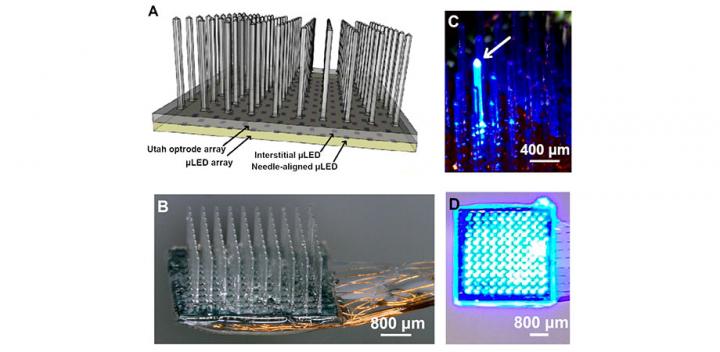BELLINGHAM, Washington, USA and CARDIFF, UK – In an article published in the peer-reviewed, open-access
SPIE
publication
Neurophotonics
,
“A multi-site microLED optrode array for neural interfacing,”
researchers present an implantable optrode array capable of exciting below-surface neurons in large mammal brains at two levels, both by structured-light delivery and large-volume illumination. This development is promising for studies aiming to link neural activity to specific cognitive functions in large mammals.
While other optogenetic devices have been previously developed, this latest innovation addresses a multitude of ongoing challenges and improvements when it comes to optical stimulation and neuroscience in large animal models. Enhanced elements include depth of access, heat control, and an electric delivery system compatible with future wireless applications. This is achieved by connecting a glass needle array to a custom-built microLED array and creating a compact and lightweight device optimally suited for behavioral studies.
This new technology heralds exciting potential for new mammalian behavioral discoveries, according to
Neurophotonics
Associate Editor Anna Wang Roe, a professor in the Division of Neuroscience at the Oregon National Primate Research Center and director of the Interdisciplinary Institute of Neuroscience and Technology at Zhejiang University in Hangzhou, China. “The development of a large array multisite optical stimulator is a significant advance in the field of optogenetics and optical stimulation,” she said. “Having this array will lead to the ability to stimulate multiple cortical sites simultaneously or sequentially, in a cell-type specific manner. It may also open up the possibility of stimulating with different wavelengths, and therefore different cell types, at selected locations. This capability broadens the menu of possible stimulation paradigms for brain-machine interface.”
###
The article authors are Niall McAlinden, Yunzhou Cheng, Enyuan Xie, Erdan Gu, Martin D. Dawson, and Keith Mathieson of the University of Strathclyde’s Institute of Photonics, Glasgow, Scotland; Robert Scharf, Christopher F. Reiche, Steve Blair, Prashant Tathireddy and Rohit Sharma, of the University of Utah’s Department of Electrical and Computer Engineering, Salt Lake City, United States; and Loren Rieth of the Fienstein Institute for Medical Research, Manhasset, New York, United States. This work was funded by the NIH through the US BRAIN Initiative.
Neurophotonics
is published in print and digitally by SPIE in the SPIE Digital Library. The SPIE Digital Library contains more than 500,000 publications from SPIE journals, proceedings, and books, with approximately 18,000 new research papers added each year.
About SPIE
SPIE is the international society for optics and photonics, an educational not-for-profit organization founded in 1955 to advance light-based science, engineering, and technology. The Society serves 257,000 constituents from 173 countries, offering conferences and their published proceedings, continuing education, books, journals, and the SPIE Digital Library. In 2018, SPIE provided more than $4 million in community support including scholarships and awards, outreach and advocacy programs, travel grants, public policy, and educational resources.
http://www.
org
.
Contact:
Daneet Steffens
Public Relations Manager
+1 360 685 5478
This part of information is sourced from https://www.eurekalert.org/pub_releases/2019-08/ssfo-noa082819.php
Daneet Steffens
617-952-1871
[email protected]
http://spie.org/


